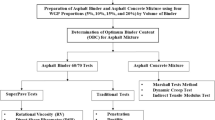Abstract
The objective of this paper was to investigate the effect of carbon nanotubes (CNTs) as binder modifier on the rutting and cracking performances of asphalt mixtures. For this purpose, the different CNTs contents (0.05, 0.1, 0.15, 0.2, and 0.25 wt%) were added into the conventional asphalt binder. The Marshall stability (MS), indirect tensile (IDT), static modulus (SM), wheel tracking (WT) test, and semi-circular bending (SCB) fracture tests were conducted to evaluate the performance resistance of CNTs-modified asphalt binder for hot mix asphalt (HMA) mixtures. The results indicated that the addition of CNTs increased rutting resistance at high temperature and cracking resistance at intermediate temperature significantly. In addition, it was found from SCB test that the strain energy release rate (Jc) of 0.1% CNTs content was 16% higher than that of the control mixture. Finally, based on the results of the laboratory test and the construction cost analysis, it can be concluded that an optimum CNTs content of 0.1% by asphalt weight may be used as additive for asphalt binder in asphalt mixtures.












Similar content being viewed by others
References
Zou G, Xu J, Wu C (2017) Evaluation of factors that affect rutting resistance of asphalt mixes by orthogonal experiment design. Internat J Pavement Res Technol 10:282–288. https://doi.org/10.1016/j.ijprt.2017.03.008
Hung NV, Le VP (2019) Performance evaluation of sulfur as alternative binder additive for asphalt mixtures. Internat J Pavement Res Technol 12:380–387. https://doi.org/10.1007/s42947-019-0045-9
Hamedi GH (2018) Effects of polymeric coating the aggregate surface on reducing moisture sensitivity of asphalt mixtures. Internat J Civil Eng 16:1097–1107. https://doi.org/10.1007/s40999-017-0263-y
Ma T, Wang H, Zhao Y, Huang X, Wang S (2017) Laboratory investigation of crumb rubber modified asphalt binder and mixtures with warm-mix additives. Internat J Civil Eng 15:185–194. https://doi.org/10.1007/s40999-016-0040-3
Geckil T, Ahmedzade P, Alatas T (2018) Effect of carbon black on the high and low temperature properties of bitumen. Internat J Civil Eng 16:207–218. https://doi.org/10.1007/s40999-016-0120-4
Bai JB, Allaoui A (2003) Effect of the length and the aggregate size of MWNTs on the improvement. Compos Part A 34:689–694. https://doi.org/10.1016/S1359-835X(03)00140-4
Faramarzi M, Arabani M, Haghi AK, Mottaghitalab V (2014) Carbon Nanotubes-modified asphalt binder: preparation and characterization. Internat J Pavement Res Technol 8:29–37. https://doi.org/10.6135/ijprt.org.tw/2015.8(1).29
Goli A, Aff.M.ASCE; Ziari H, Amini A (2017) Influence of carbon nanotubes on performance properties and storage stability of sbs modified asphalt binders. J Mater Civil Eng (ASCE) 29:1–8. https://doi.org/10.1061/(ASCE)MT.1943-5533.0001910
Amin I, Badawy SM, Badawy T, Brakah T, Ibrahim M (2016) Laboratory evaluation of asphalt binder modified with carbon nanotubes for Egyptian climate. Constr Build Mater 121:361–372. https://doi.org/10.1016/j.conbuildmat.2016.05.168
Akbari M, Kiasat A, Mirzaei E, Omidi BF, Birgani O (2012) Bitumen modification using carbon nanotubes. World Appl Sci J 18:594–599. https://doi.org/10.5829/idosi.wasj.2012.18.04.1443
Santagata E, Baglieri O, Tsantilis L, Dalmazzo D (2012) Rheological characterization of bituminous binders modified with carbon nanotubes. Proc Soc Behav Sci 53:546–555. https://doi.org/10.1016/j.sbspro.2012.09.905
Zahedi M, Barati M, Zarati M (2017) Evaluation the effect of carbon nanotube on the rheological and mechanical properties of bitumen and hot mix asphalt (HMA). Electronic J Struct Eng 17:76–84
American Standard (2001) Standard test method for sieve analysis of fine and coarse aggregates. ASTM C136:10–301. https://doi.org/10.1520/C0136_C0136M-19
American Standard (2006) Standard test method for marshall stability and flow of bituminous mixtures. ASTM D6927(10):20–56. https://doi.org/10.1520/D6927-06
American Standard (2007) Standard test method for indirect tensile (IDT) strength of bituminous mixtures. Astm. https://doi.org/10.1520/D6931-07
American Standard (2002) Standard test method for compressive strength of bituminous mixtures. Astm. https://doi.org/10.1520/D1074-17
Bituminous mixtures (2003) Test methods for hot mix asphalt. Wheel tracking. BS EN. https://standards.globalspec.com/std/14257224/EN%2012697-22
American Standard (2016) Standard test method for evaluation of asphalt mixture cracking resistance using the semi-circular bend test (SCB) at intermediate temperatures. ASTM. https://doi.org/10.1520/D8044-16
American Standard (2013) Standard Test Method for Penetration of Bituminous Materials. ASTM. https://doi.org/10.1520/D0005_D0005M-13
American Standard (2014) Standard test method for softening point of bitumen (Ring-and-Ball Apparatus). ASTM. https://doi.org/10.1520/D0036_D0036M-14
American Standard (2018) Standard test method for viscosity of asphalts by vacuum capillary viscometer. ASTM. https://doi.org/10.1520/D2171_D2171M-18
American Standard (2007) Standard test method for ductility of bituminous materials (Withdrawn 2016). ASTM. https://doi.org/10.1520/D0113-07
American Standard (2020) Standard test methods for flash point by pensky-martens closed cup tester. ASTM. https://doi.org/10.1520/D0093-20
American Standard (2003) Standard test method for specific gravity and density of semi-solid bituminous materials. ASTM. https://doi.org/10.1520/D0070-03
American Standard (2020) Standard test method for effects of heat and air on asphaltic materials (Thin-Film Oven Test). ASTM. https://doi.org/10.1520/D1754_D1754M-20
Acknowledgements
This research is funded by University of Transport and Communications (UTC) under Grant number T2019-PHII-014TĐ.
Author information
Authors and Affiliations
Corresponding author
Rights and permissions
About this article
Cite this article
Bach Le, V., Phuc Le, V. Performance Evaluation of Carbon Nanotubes as a Binder Modifier for Asphalt Mixtures. Int J Civ Eng 19, 1143–1153 (2021). https://doi.org/10.1007/s40999-020-00599-0
Received:
Revised:
Accepted:
Published:
Issue Date:
DOI: https://doi.org/10.1007/s40999-020-00599-0




